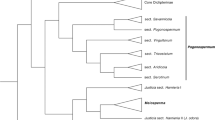Abstract
This study addresses reported discrepancies regarding the occurrence of Polypodium calirhiza in Mexico. The original paper describing this taxon cited collections from Mexico, but the species was omitted from the recent Pteridophytes of Mexico. Originally treated as a tetraploid cytotype of P. californicum, P. calirhiza now is hypothesized to have arisen through hybridization between P. glycyrrhiza and P. californicum. The tetraploid can be difficult to distinguish from either of its putative parents, but especially so from P. californicum. Our analyses show that a combination of spore length and abaxial rachis scale morphology consistently distinguishes P. calirhiza from P. californicum, and we confirm that both species occur in Mexico. Although occasionally found growing together in the United States, the two species are strongly allopatric in Mexico: P. californicum is restricted to coastal regions of the Baja California peninsula and neighboring Pacific islands, whereas P. calirhiza grows at high elevations in central and southern Mexico. The occurrence of P. calirhiza in Oaxaca, Mexico, marks the southernmost extent of the P. vulgare complex in the Western Hemisphere.



Similar content being viewed by others
Literature Cited
Abramoff, M. D., P. J. Magelhaes & S. J. Ram. 2004. Image processing with ImageJ. Biophotonics International 7: 36–42.
Baldwin, B. G., D. H. Goldman, D. J. Keil, R. Patterson, T. J. Rosatti & D. H. Wilken (eds.). 2012. The Jepson Manual: vascular plants of California, second edition. University of California Press, Berkeley.
Barrington, D. S., C. A. Paris & T. A. Ranker. 1986. Systematic inferences from spore and stomate size in the ferns. American Fern Journal 76: 149–159.
Beck, J. B., M. D. Windham, G. Yatskievych & K. M. Pryer. 2010. A diploids-first approach to species delimitation and interpreting polyploid evolution in the fern genus Astrolepis (Pteridaceae). Systematic Botany 35: 223–234.
de la Luz, L., J. Luis, P. Navarro, J. Juan & A. Breceda. 2000. A transitional xerophytic tropical plant community of the Cape Region, Baja California. Journal of Vegetative Science 11: 555–564.
Grusz, A. L., M. D. Windham & K. M. Pryer. 2009. Deciphering the origins of apomictic polyploids in the Cheilanthes yavapensis complex (Pteridaceae). American Journal of Botany 96: 1636–1645.
Haufler, C. H., M. D. Windham & E. W. Rabe. 1995a. Reticulate evolution in the Polypodium vulgare complex. Systematic Botany 20: 89–109.
———, D. E. Soltis & P. S. Soltis. 1995b. Phylogeny of the Polypodium vulgare complex: Insights from chloroplast DNA restriction site data. Systematic Botany 20: 110–119.
——— , M. D. Windham, F. A. Lang & S. A. Whitmore. 1993. Polypodium. Pp. 315–323 In: Flora of North America Editorial Committee (ed.), Flora of North America north of Mexico. Oxford University Press, New York.
Hugo, R. & E. Exequiel. 2007. Endemic regions of the vascular flora of the peninsula of Baja California, Mexico. Journal of Vegetative Science 18: 327–336.
Kott, L. S. & D. M. Britton. 1982. A comparative study of sporophyte morphology of the three cytotypes of Polypodium virginianum in Ontario. Canadian Journal of Botany 60: 1360–1370.
Li, F. W., K. M. Pryer & M. D. Windham. 2012. Gaga, a new genus segregated from Cheilanthes (Pteridaceae). Systematic Botany 37: 845–860.
Lloyd, R. M. 1963. New chromosome numbers in Polypodium L. American Fern Journal 53: 99–101.
——— & F. A. Lang. 1964. The Polypodium vulgare complex in North America. British Fern Gazette 9: 168–177.
Manton, I. 1951. Cytology of Polypodium in America. Nature 167: 37.
Mickel, J. T. & J. M. Beitel. 1988. Pteridophyte flora of Oaxaca, Mexico. Memoirs of the New York Botanical Garden 46: 1–568.
——— & A. R. Smith. 2004. The Pteridophytes of Mexico. New York: The New York Botanical Garden Press.
Microsoft. 2011. Microsoft Excel v. 14.1. Redmond, Washington: Microsoft, Computer Software.
Pryer, K. M. & D. M. Britton. 1983. Spore studies in the genus Gymnocarpium. Canadian Journal of Botany 61: 377–388.
R Development Core Team. 2008. R: A language and environment for statistical computing. R Foundation for Statistical Computing, Vienna, Austria.
Raven, P. H. & D. I. Axelrod. 1978. Origin and relationships of the California flora. University of California Publications in Botany 72: 1–134.
Sigel, E. M., M. D. Windham. C. Haulfer & K. M. Pryer. In review. Phylogeny, divergence time estimates, and phylogeography of the diploid species of the Polypodium vulgare complex. Systematic Botany.
Sigel, E. M., M. D. Windham, L. Huiet, G. Yatskievych & K. M. Pryer. 2011. Species relationships and farina evolution in the cheilanthoid fern genus Argyrochosma (Pteridaceae). Systematic Botany 36: 554–564.
Wagner Jr., W. H. 1974. Structure of spores in relation to fern phylogeny. Annals of the Missouri Botanical Garden 61: 332–353.
Whitmore, S. A. & A. R. Smith. 1991. Recognition of the tetraploid Polypodium calirhiza (Polypodiaceae) in western North America. Madroño 38: 233–248.
Whittier, P. and W. H. Wagner, Jr. 1971. The variation in spore size and germination in Dryopteris taxa. American Fern Journal 61: 123–127.
Windham, M. D. & G. Yatskievych. 2003. Chromosome studies of cheilanthoid ferns (Pteridaceae: Cheilanthoideae) from the western United States and Mexico. American Journal of Botany 90: 1788–1800.
Acknowledgments
The authors thank the curators and staff at the DUKE, JEPS, NY, and UC herbaria for loans and permission to sample spores and scales, without which this study would not have been possible. We are grateful to Amanda Grusz, Layne Huiet, Fay-Wei Li, Anne Johnson, Carl Rothfels, and manuscript reviewers for their helpful comments and edits. The National Science Foundation Doctoral Dissertation Improvement Grant 1110775 to K.M.P. and E.M.S. supported this research. This article is part of E.M.S.’s doctoral dissertation in Biology at Duke University.
Author information
Authors and Affiliations
Corresponding author
Rights and permissions
About this article
Cite this article
Sigel, E.M., Windham, M.D., Smith, A.R. et al. Rediscovery of Polypodium calirhiza (Polypodiaceae) in Mexico. Brittonia 66, 278–286 (2014). https://doi.org/10.1007/s12228-014-9332-6
Published:
Issue Date:
DOI: https://doi.org/10.1007/s12228-014-9332-6




